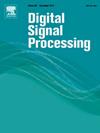动态二阶光滑变结构滤波器的协方差重构及其在目标跟踪中的应用
IF 2.9
3区 工程技术
Q2 ENGINEERING, ELECTRICAL & ELECTRONIC
引用次数: 0
摘要
在目标跟踪中常用的滤波器是卡尔曼滤波器(KF)。然而,当存在建模误差时,它的性能会下降,并且可能变得不稳定。目标机动引入了建模误差。平滑变结构滤波器(SVSF)是一种基于变结构系统理论的鲁棒滤波器,用于解决实际应用中常见的建模误差。本文对动态二阶光滑变结构滤波器(DSO-SVSF)的协方差进行了重新表述。它被重新表述,因为该滤波器的当前协方差是近似的,在这项工作中,导出了一个精确的协方差。在目标跟踪中,精确的滤波协方差是数据关联的必要条件。尽管DSO-SVSF不需要协方差来更新状态,但协方差对于目标跟踪执行数据关联是必需的。本文涉及以下原创性理论贡献:i)具有平方和非平方输出矩阵的线性系统的DSO-SVSF的协方差重新表述,以及ii)使用重新表述的协方差的概率数据关联滤波器(PDAF)的表述。应用贡献包括:iii)将所提出的协方差用于目标跟踪中的数据关联;iv)将所提出的PDAF与其他PDAF在仿真中的目标跟踪性能进行比较。提出的协方差称为随机增益协方差(SGC)。将所提出的PDAF应用于目标跟踪仿真。基线包括基于kf的PDA公式,使用DSO-SVSF及其近似协方差的PDAF,以及使用原始二阶SVSF (SO-SVSF)及其近似协方差的PDAF。本文章由计算机程序翻译,如有差异,请以英文原文为准。

Covariance reformulations of the dynamic second-order smooth variable structure filter with applications to target tracking
A popular filter in target tracking is the Kalman Filter (KF). However, its performance degrades when modeling error is present and it may become unstable. Target maneuvers introduce modeling errors. The Smooth Variable Structure Filter (SVSF) is a robust filter formulated based on variable structure system theory to address modeling errors, which are common in practice. This paper reformulates the covariance of an SVSF variant known as the Dynamic Second-Order Smooth Variable Structure Filter (DSO-SVSF). It is reformulated because the current covariance of that filter is approximate, and in this work, an exact covariance is derived. An accurate filter covariance is necessary for data association in target tracking. Although the DSO-SVSF does not require a covariance to update the state, the covariance is necessary for target tracking to perform data association. This paper involves the following original theoretical contributions: i) covariance reformulation of the DSO-SVSF for linear systems with square and non-square output matrices, and ii) formulation of a Probabilistic Data Association Filter (PDAF) that uses the reformulated covariance. The applied contributions are: iii) application of the proposed covariance for data association in target tracking, and iv) comparison of the target tracking performance of the proposed PDAF to other PDAFs in simulations. The proposed covariance is referred to as Stochastic Gain Covariance (SGC). The proposed PDAF is applied to perform target tracking in simulations. The baselines include the KF-based formulation of PDA, a PDAF that employs the DSO-SVSF and its approximate covariance, and a PDAF that uses the original Second-Order SVSF (SO-SVSF) and its approximate covariance.
求助全文
通过发布文献求助,成功后即可免费获取论文全文。
去求助
来源期刊

Digital Signal Processing
工程技术-工程:电子与电气
CiteScore
5.30
自引率
17.20%
发文量
435
审稿时长
66 days
期刊介绍:
Digital Signal Processing: A Review Journal is one of the oldest and most established journals in the field of signal processing yet it aims to be the most innovative. The Journal invites top quality research articles at the frontiers of research in all aspects of signal processing. Our objective is to provide a platform for the publication of ground-breaking research in signal processing with both academic and industrial appeal.
The journal has a special emphasis on statistical signal processing methodology such as Bayesian signal processing, and encourages articles on emerging applications of signal processing such as:
• big data• machine learning• internet of things• information security• systems biology and computational biology,• financial time series analysis,• autonomous vehicles,• quantum computing,• neuromorphic engineering,• human-computer interaction and intelligent user interfaces,• environmental signal processing,• geophysical signal processing including seismic signal processing,• chemioinformatics and bioinformatics,• audio, visual and performance arts,• disaster management and prevention,• renewable energy,
 求助内容:
求助内容: 应助结果提醒方式:
应助结果提醒方式:


